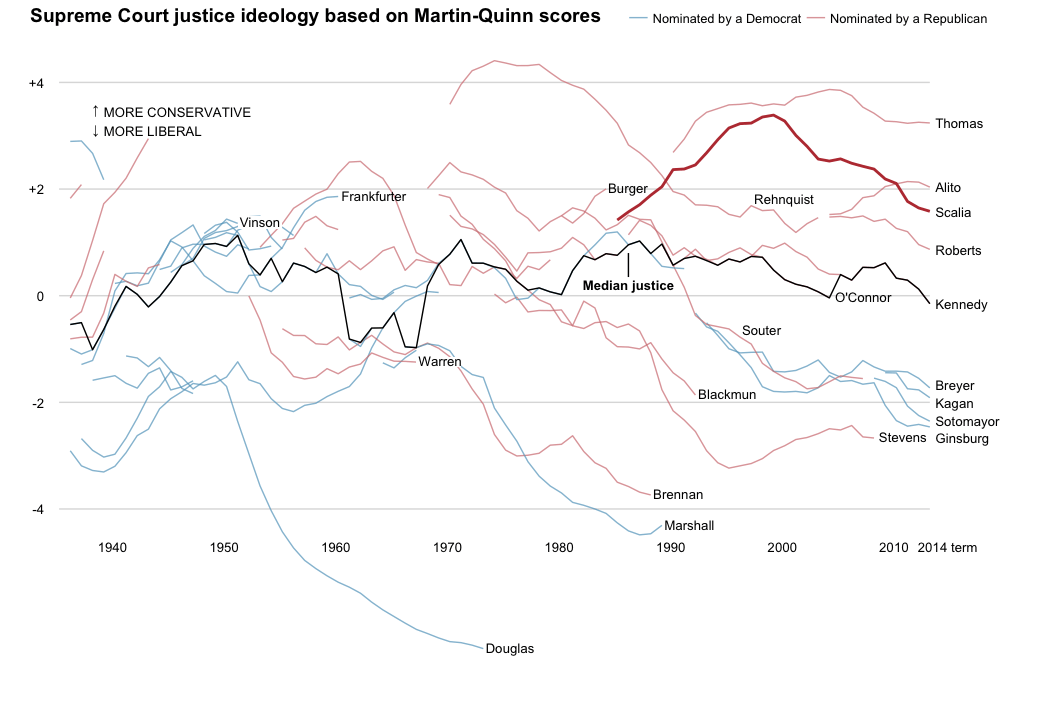How Antonin Scalia compared with other Supreme Court justices
Visualisations
Charting the swing vote in the US Supreme Court, and finding a flaw in the New York Times while we’re at it
The ever-interesting graphics department at the New York Times recently published a chart explaining the political leanings of the US Supreme Court and its justices since the late 1930s. It’s an accomplished visualisation as it’s not only beautiful but it explains the data well and tells an interesting story.
As with any good chart I had an instant urge to try and make a duplicate, both as a learning exercise so I can better understand data visualisation, and so I can try and push my knowledge of my tools of choice, R and ggplot2. So I opened up RStudio and started work. A few hours later, I had this.

Ideology of Supreme Court justices since 1937, based on Martin-Quinn scores. The death of justice Antonin Scalia leaves the court with equal numbers of conservative and liberal justices.
While not quite an exact replica it comes close, and certainly all the important aspects are there. When you copy something so closely you notice the details, those things you registered unconsciously when you first saw the chart but now see clearly: the shifted x-axis, the zero-centred y-axis, the efficient use of space, the attention to detail on the labels. It’s not the first chart to visualise the data like this — both the data source and Wikipedia have similar charts — but it is the best I’ve seen. Even though I only made a copy I’m quite proud of this. You can see the source code on GitHub.
Although the chart’s focus was Antonin Scalia, the justice who’d died a few days earlier, of equal historical importance was the median justice, the ’justice in the middle of a distribution of justices, such that (in an ideological distribution, for example) half the justices are to the right of (more ‘conservative’ than) the median and half are to the left of (more ‘liberal’ than) the median.’1. Following this line you can see the centre of the Supreme Court in any given term, and from where on the ideological spectrum that important centre vote would come in a 5–4 decision2.
And that’s when I noticed a flaw in the Times’s graphic. Look closely at the first decade, up until 1946, and you’ll see some, but not all, of the court’s nine justices are shown. Missing are George Sutherland (resigned 1938), Benjamin Cardozo (died 1938), James McReynolds (resigned 1941), Charles Evans Hughes (chief justice until 1941), Owen Roberts (resigned 1945), Harlan Stone (died 1946), and — worst of all — Hugo Black, who served for 34 years until 1971 and was the median justice for a short time in the late 1960s.
You could perhaps make an argument for hiding these judges in order to simplify the information on chart. I’m not sure I’d agree but it wouldn’t necessarily be a problem. What is a problem is that the missing justices were also forgotten when the median was calculated. The median line is wrong up until 1946 (when all but one of the missing justices has left the court), and wrong again in the late 60s when it should match the missing Black.
I’m not going to say I wasn’t delighted to discover this. It’s one thing to try and copy talented people, it’s another to be able to help them improve their work. (I’ve emailed the paper to suggest a correction.) And I doubt this was a deliberate decision: the missing justices all started their terms before the period covered by the chart so it’s likely the Times mistakenly selected only those justices whose terms started within that period, skipping those already on the court.
But by removing a handful of mostly conservative justices from their chart the New York Times has made the US Supreme Court look more liberal than it actually was, and it should be corrected.
Update, 9 March 2016
After my email to the Times went unacknowledged for two weeks, I took to Twitter. The Times corrected the error five days later. The median line was recalculated but the missing justices remain missing. Both the error and the omission are noted.
Andrew D. Martin, Kevin M. Quinn, and Lee Epstein, The Median Justice on the United States Supreme Court, 83 N.C. L. Rev. 1275 (2004).
Apart from a few years in the mid 1860s there have been nine Supreme Court seats since 1837.